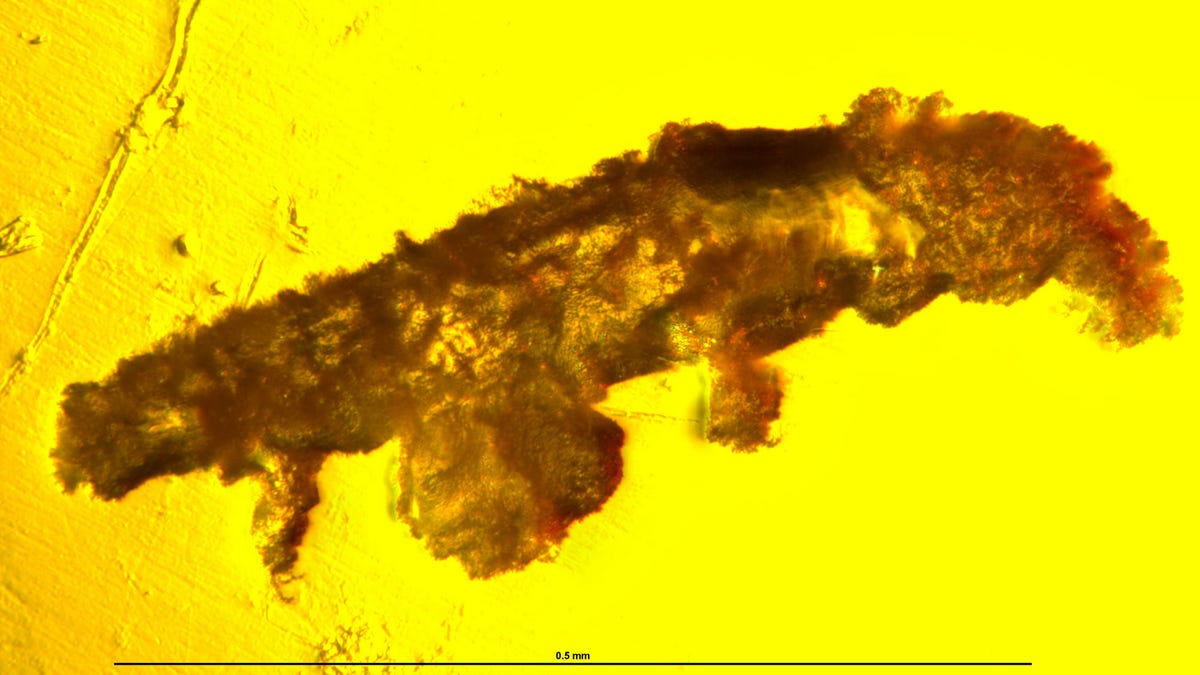Tardigrade trapped in 16-million-year-old amber a 'once in a generation' find
It's about as rare as they come: An ancient water bear, entombed in tree resin.

This lateral view of Paradoryphoribius chronocaribbeus shows how it looks with a stereomicroscope.
A long, long time ago, a miniscule animal met its end in a sticky trap of tree resin. Sixteen million years later, that tiny tardigrade fossil was discovered in Dominican amber. It's now something of a science celebrity. Talk about a glow-up.
The fossil tardigrade is remarkable for its rarity and for being a new species and a new genus.
Tardigrades are known as "water bears" due to their appearance when seen under a microscope (here's what they look like when they walk). They're nearly invincible, able to survive exposure to space and even being shot out of a gas gun (to a point).
While the fossil micro-animal looked like a modern tardigrade on the outside, researchers were also able to examine its innards. "Of all the currently known and formally named tardigrade amber fossils (three so far, including this Dominican amber fossil), this is the first fossil wherein we were able to visualize its internal structure (i.e. foregut)," Marc Mapalo, a doctoral candidate at Harvard University, told me. Mapalo is lead author of a paper on the find published this week in the journal Proceedings of the Royal Society B.
The tardigrade was so different from known specimens it earned its own genus and the name Paradoryphoribius chronocaribbeus.
This artistic rendering shows what Paradoryphoribius chronocaribbeus might have looked like.
"The discovery of a fossil tardigrade is truly a once-in-a-generation event," said co-author Phil Barden in a New Jersey Institute of Technology statement on Tuesday. Barden's lab found the fossil.
Spotting a teensy tardigrade that's half a millimeter long in ancient amber is no easy feat. "At first I thought it was an artifact in the amber-- a crack or fissure that just happened to look a lot like a tardigrade," Barden said. The tiny claws tipped him off to what it really was.
Humans can buy tardigrade plush toys, tardigrade-emblazoned T-shirts and even tardigrade jewelry. "As microorganisms they live on a scale that is difficult to comprehend, yet they have these funny little legs and conspicuous cute faces that seem somehow familiar, like the bears they're sometimes named after," Barden said.
The Dominican amber piece with the tardigrade also contained three ants, a beetle and a flower.
While more tardigrade fossils may yet be found in other amber samples, it's a challenging mission."You could spend the rest of your life screening through amber and never find one," Barden said. He considers the discovery to be "enough tardigrade luck for one career."
Mapalo hopes the find will encourage researchers to take care when studying amber and to keep their eyes peeled for the critters. The fossilized animals can tell us about how tardigrades have changed over time. There's a lot left to learn about these mighty water bears, both ancient and modern.

